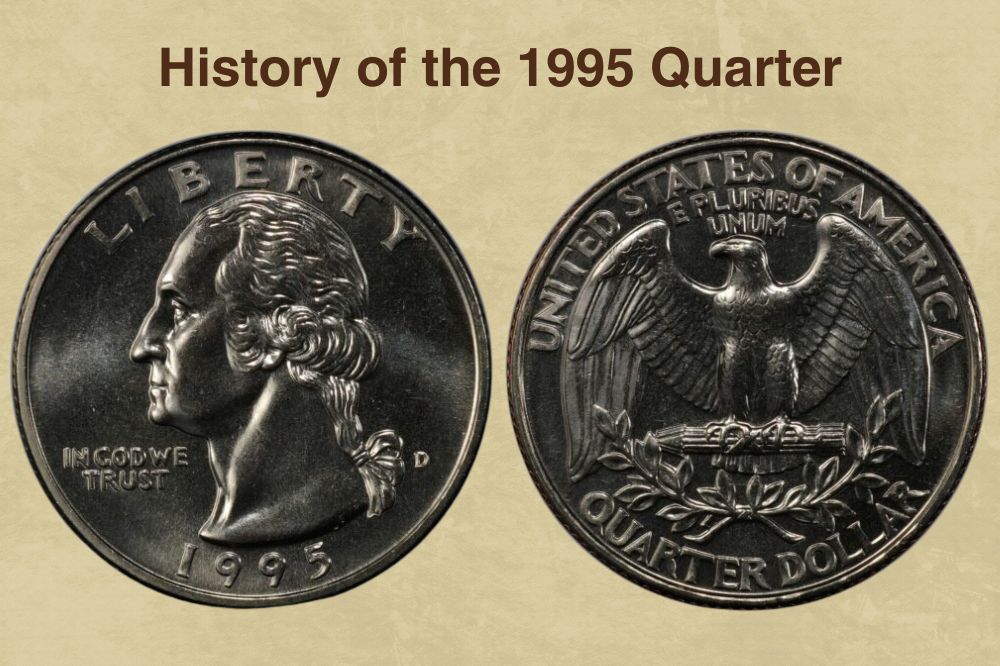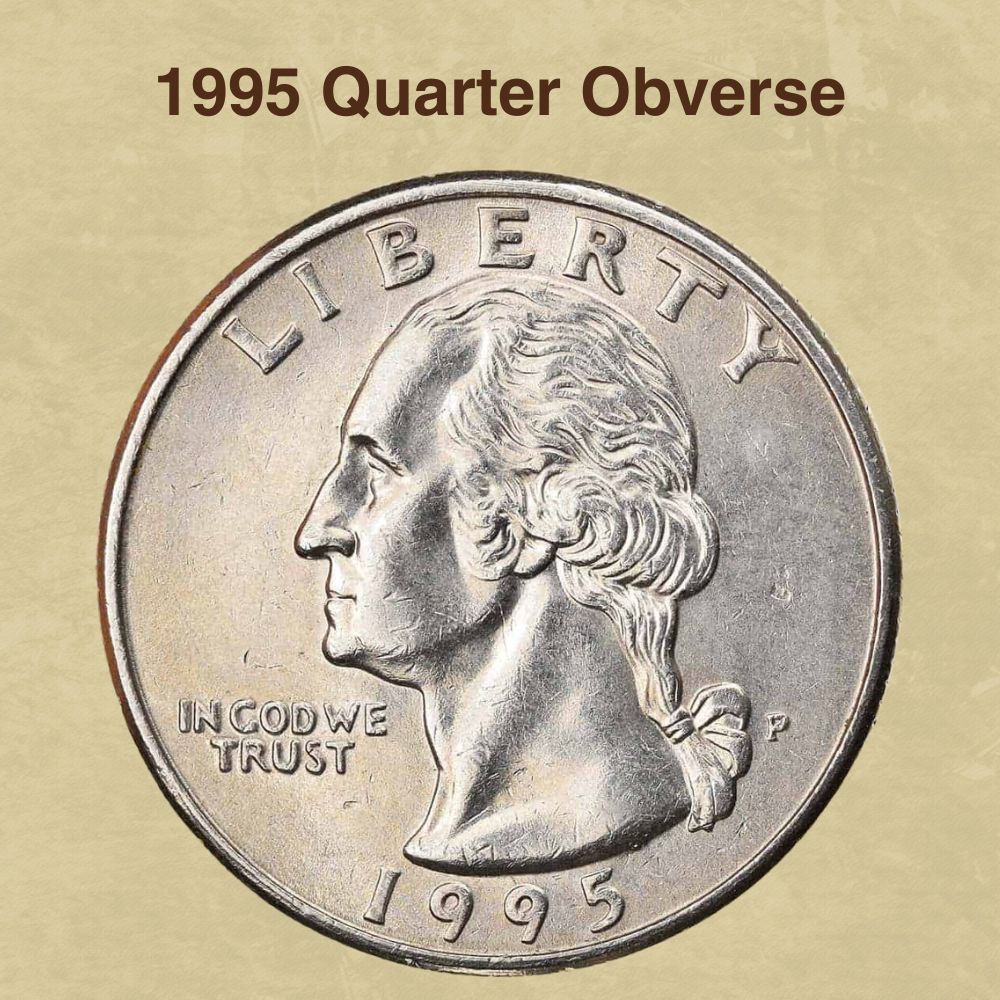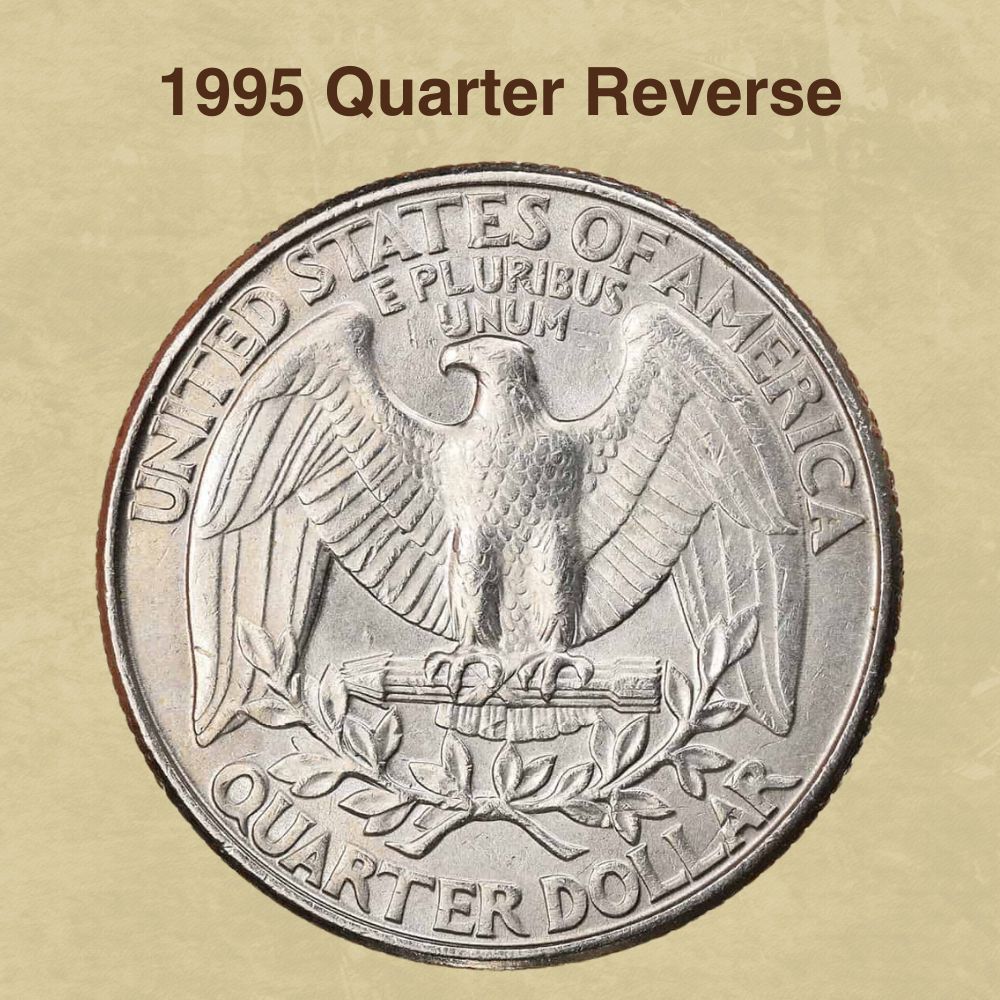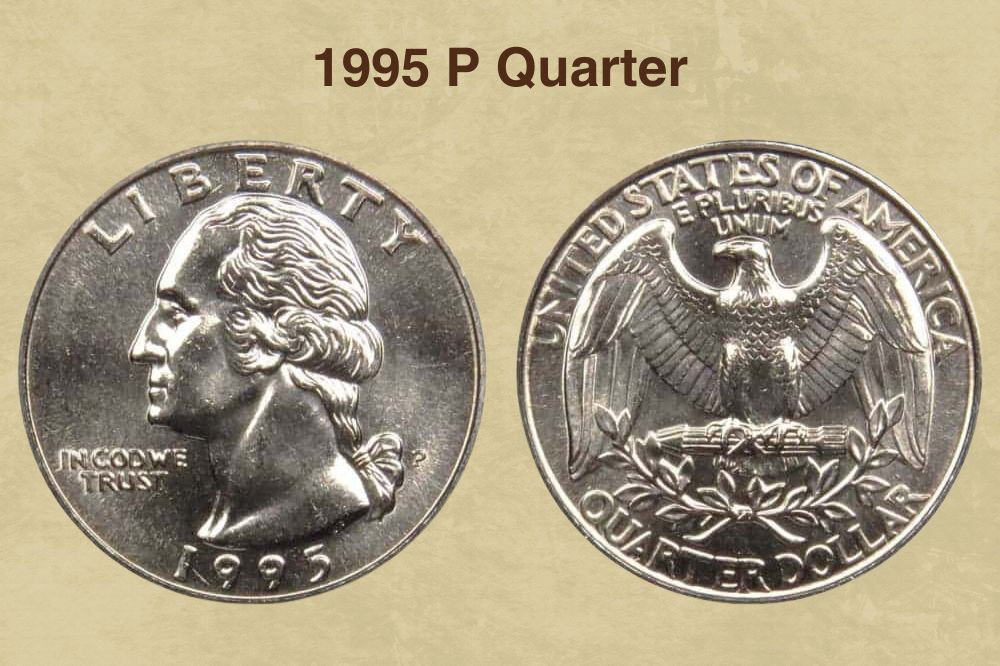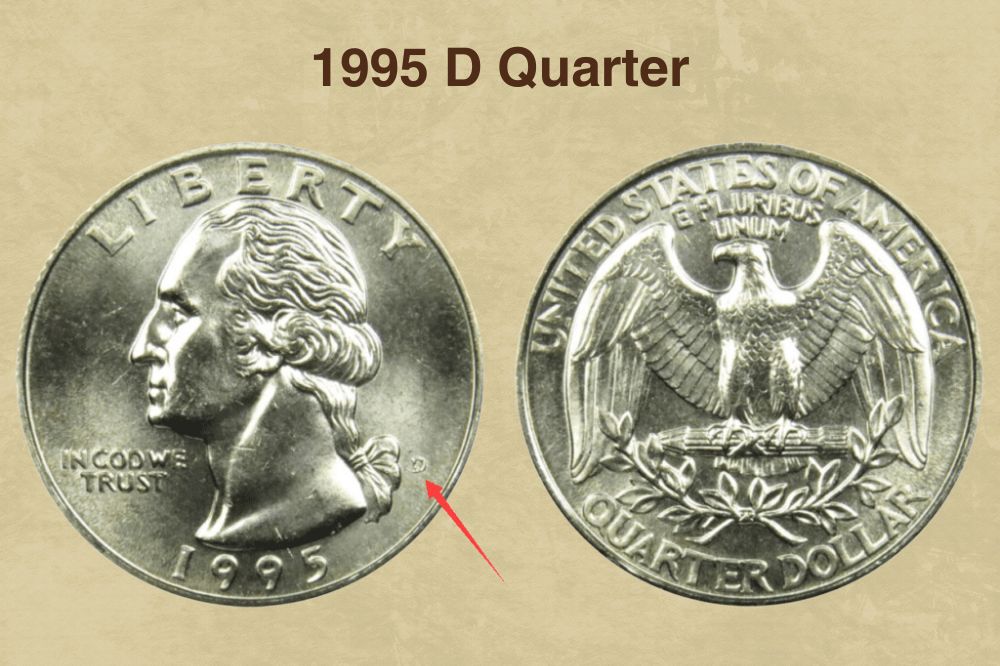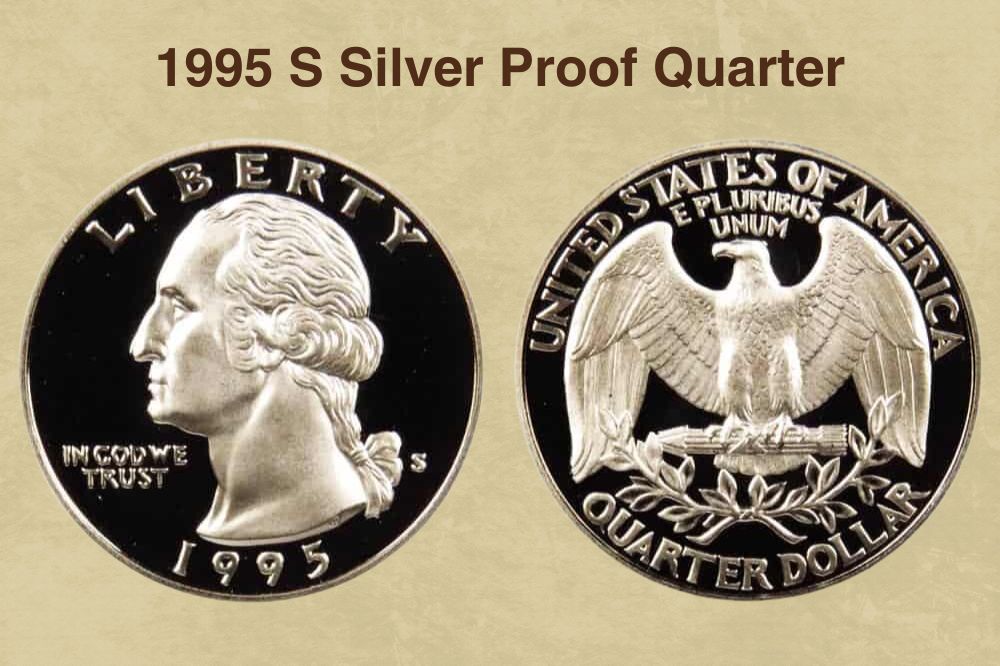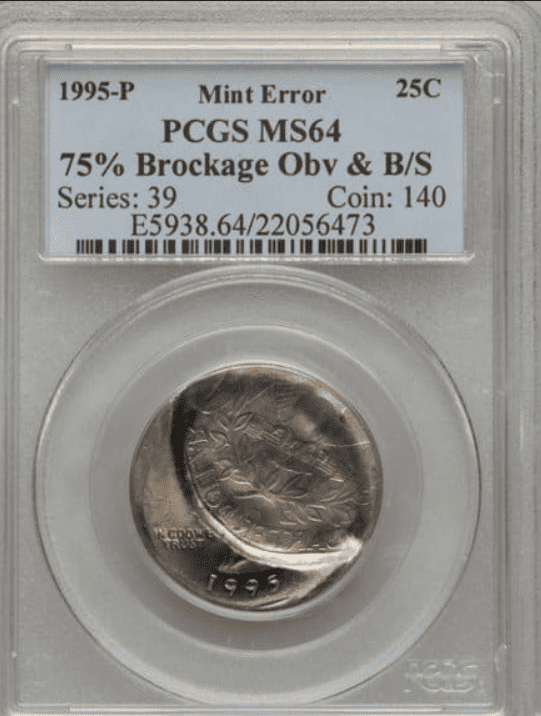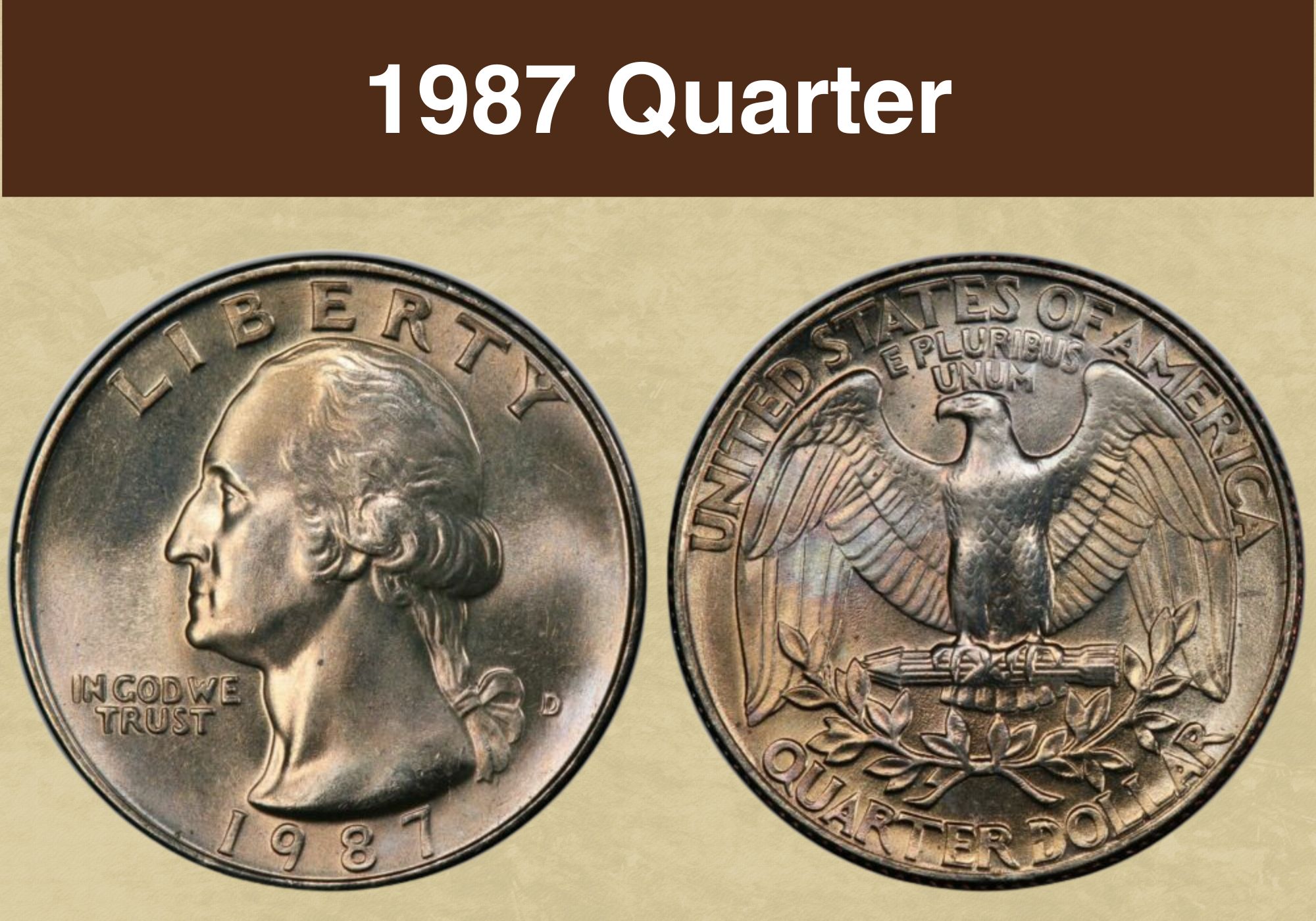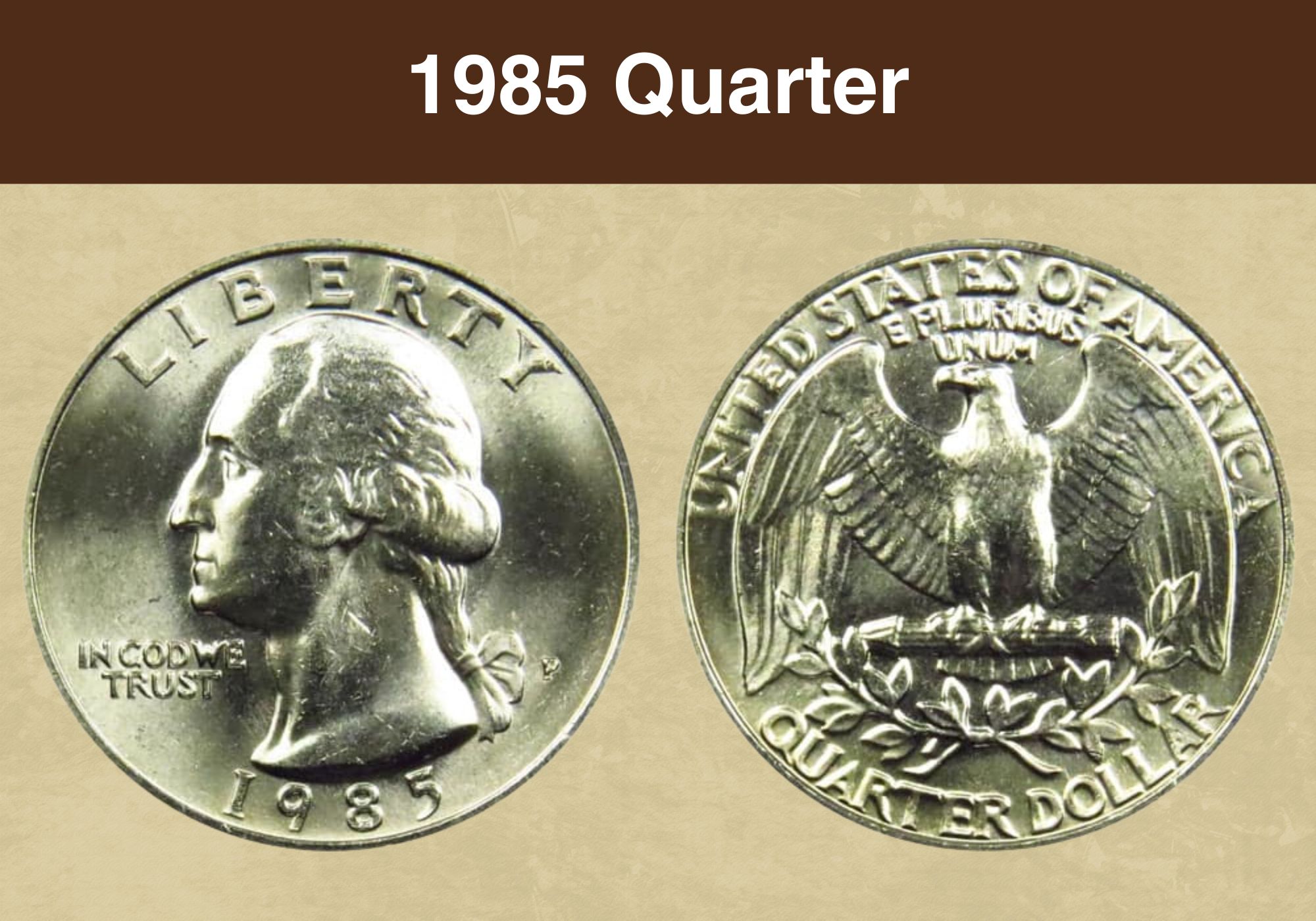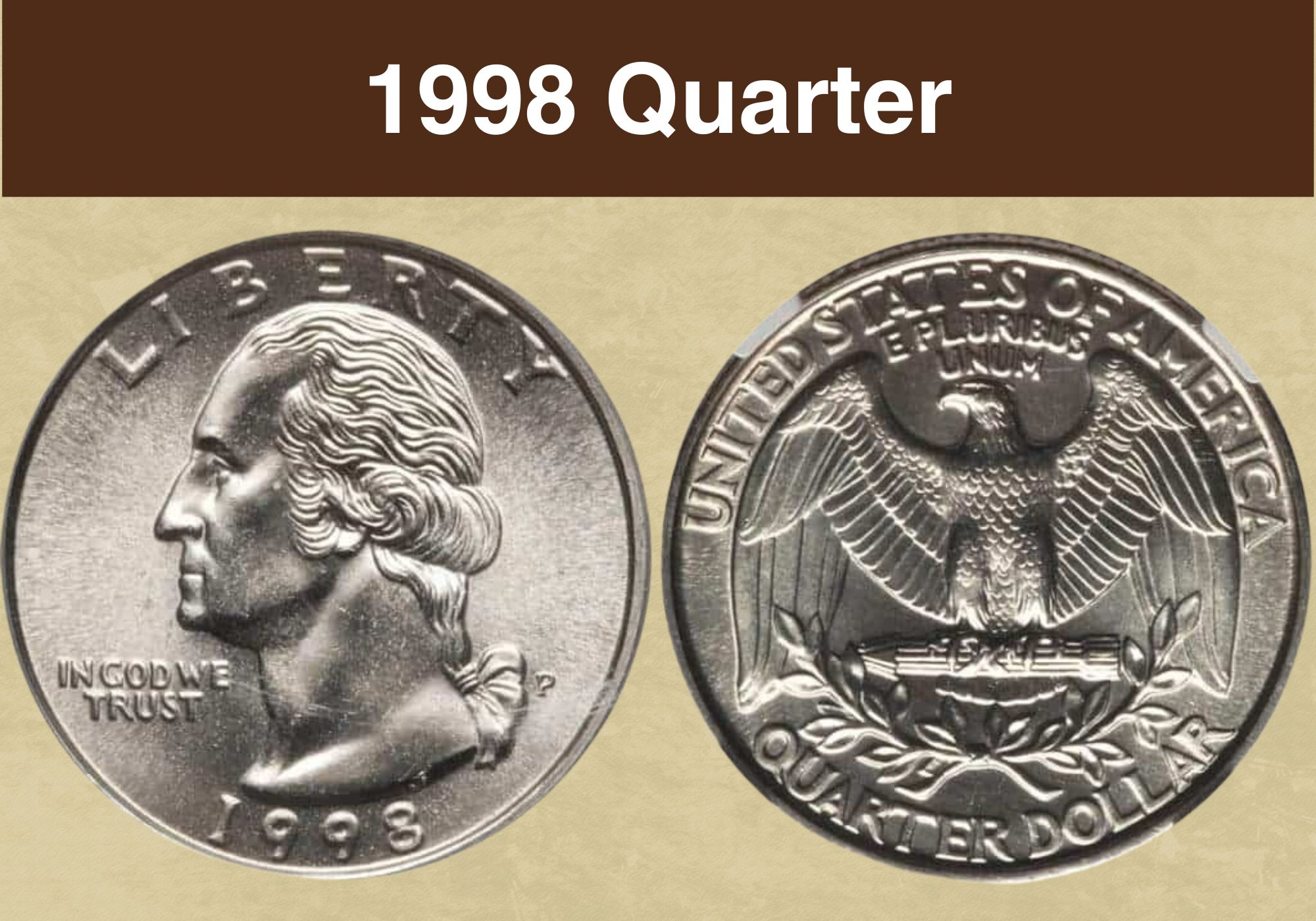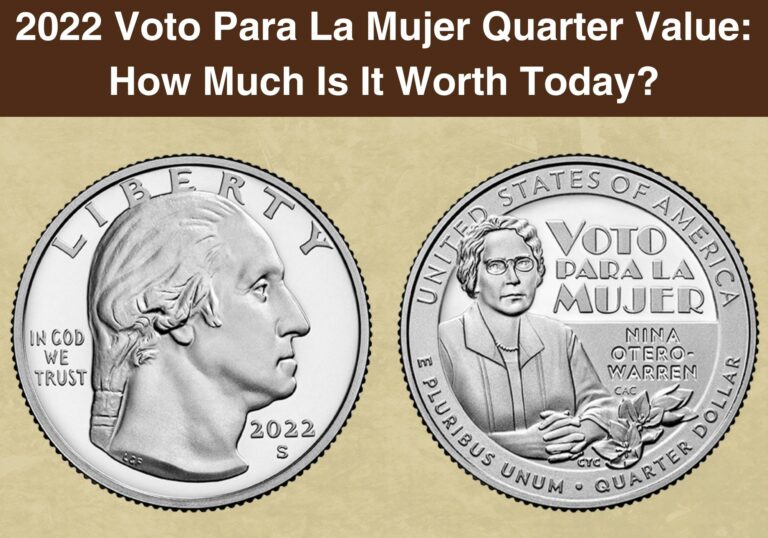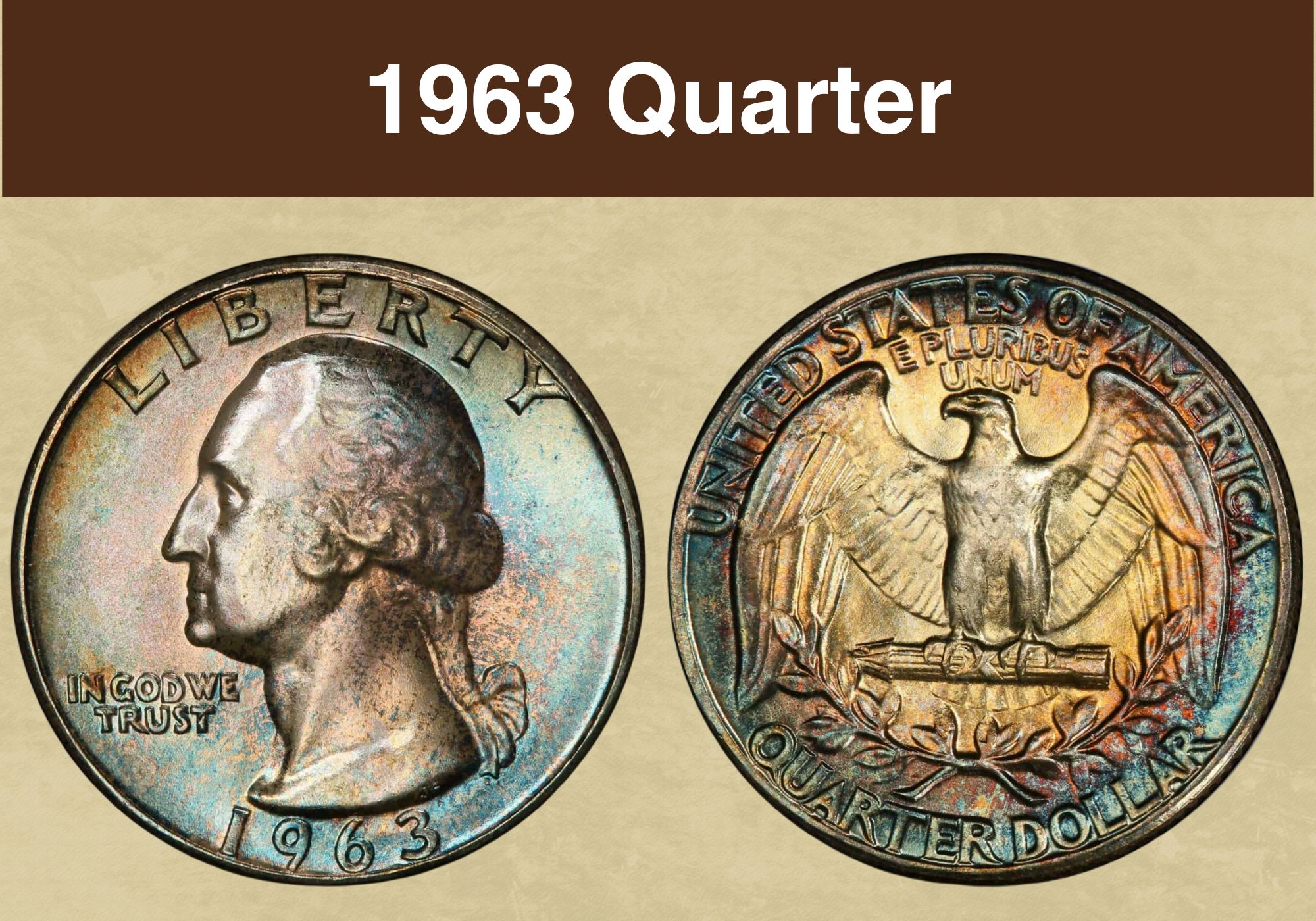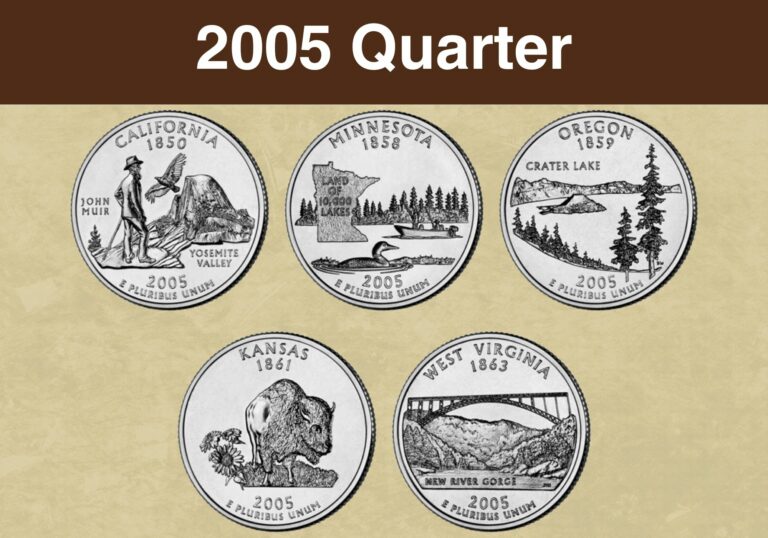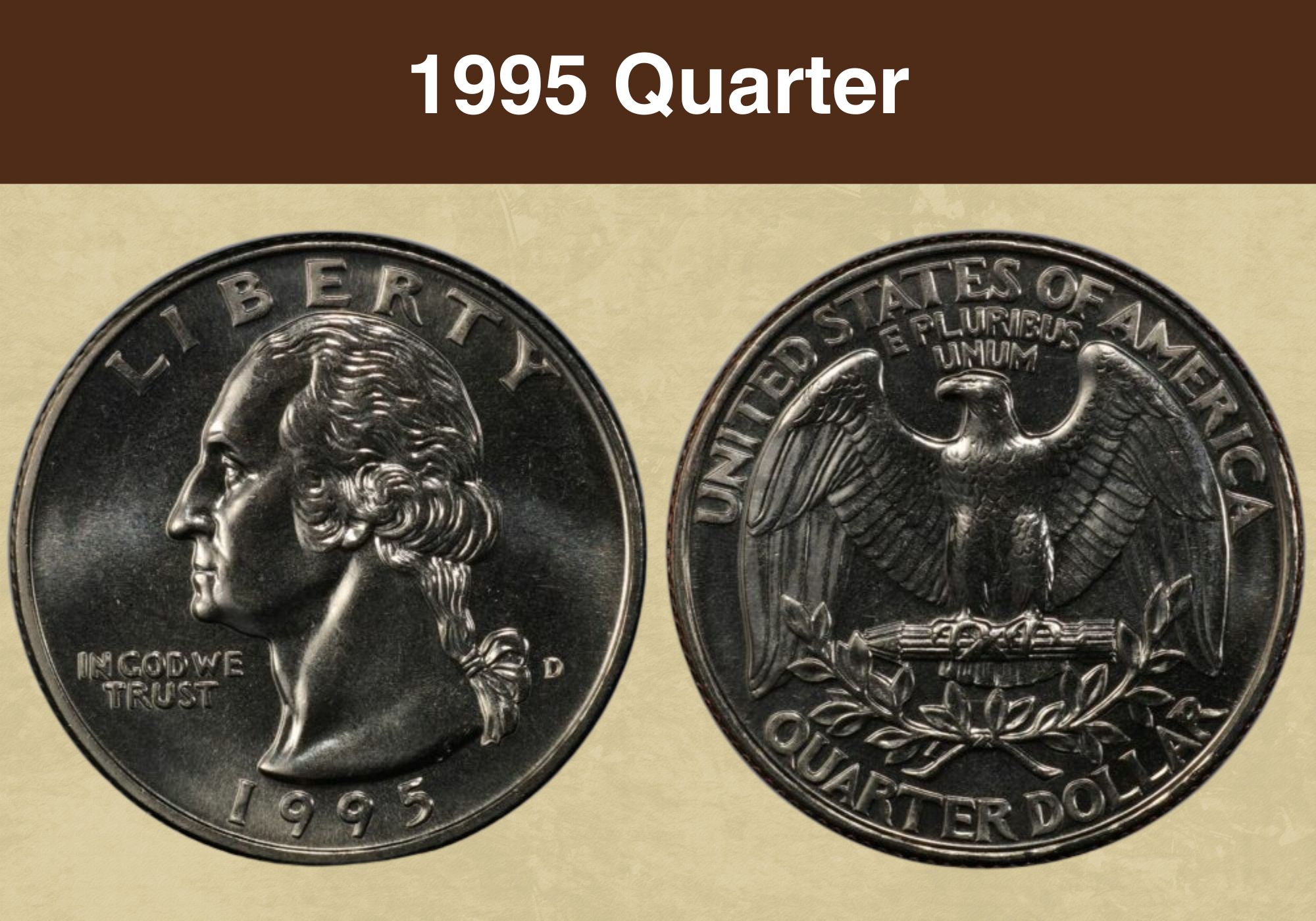
Coin Value Contents Table
Do you have a quarter dated 1995? Or are you looking to add one to your coin collection? If either of those are the case, you’ve come to the right place!
We’re going to explore the 1995 quarter value. We’ll look at how it’s affected by mint mark and condition. And we’ll check out some of the interesting Mint errors that can add a premium to prices.
So if you’re ready to find out more, let’s get started!
1995 Quarter Value Chart |
||||
| Mintmark | MS60 | MS63 | MS65 | MS68 |
| 1995 P Quarter Value | $1 | $2 | $7 | $2,850 |
| 1995 D Quarter Value | $1 | $2 | $7 | $1,250 |
| PR60 | PR65 | PR68 | PR70 | |
| 1995 S Silver Proof Quarter Value | $4 | $8 | $11 | $55 |
| 1995 S Clad Proof Quarter Value | $5 | $5 | $10 | $38 |
History of the 1995 Quarter
1995 saw four different quarters struck by the US Mint. Business strike coins were struck in Philadelphia with a “P” mint mark, and in Denver with a “D”.
And both silver and clad proofs were produced too. Both were struck at the Mint facility in San Francisco and bore the “S” mint mark.
The 1995 quarter is one of the series known as Washington quarters, after the design on the obverse. This shows a portrait of the first US president, George Washington, by the artist John Flanagan. The first Washington quarters were produced in 1932.
Until 1965, they had been made with silver. But rising silver prices meant that production costs were becoming ever higher.
Even worse, those expensive coins were being hoarded by the public, who hoped the silver content might soon be worth more than their face value.
Something had to give, and in 1964 the composition was changed to what was nicknamed at the time the “Johnson sandwich”.
The term reflected the involvement of President Lyndon B. Johnson in the change. And the sandwich referred to the construction of the new planchets. The core was made of solid copper, while the silver color came from the cladding – an alloy of 75 per cent copper and 25 per cent silver.
Washington quarters continue to be produced to this day. The original reverse was still being used in 1962, only being replaced in 1998. But since then, several different designs have been utilized.
These include the 50 States program and the America the Beautiful program. And today’s Washington quarters honor the accomplishments of American women.
Also read: Top 13 Most Valuable State Quarters Worth Money
Features of the 1995 Quarter
The Obverse of the 1995 Quarter
The quarters struck in 1995 bore the same image of the first US President, George Washington, that had graced that denomination since 1932.
It shows Washington in profile, facing to the left as the coin is viewed. The word “LIBERTY” arches over his head, while the date is at the bottom, curving parallel to the lower coin edge.
The motto “IN GOD WE TRUST” is tucked beneath his chin. And to the right of the portrait, near the coin edge, appears the mint mark. If the quarter was struck in Philadelphia, that will be a “P”, and if in Denver, there’ll be a “D”.
Washington’s portrait was the work of an artist named John Flanagan. It was selected by the Treasury Secretary at the time, Andrew D. Mellon. But his choice attracted considerable debate.
That was because a different portrait had already been chosen for a coin honoring Washington. With the bicentenary of his birth approaching, a committee had been set up to oversee the celebrations.
Amongst their proposals was a coin bearing Washington’s image, that would be issued for a single year. It was to be a half-dollar, and the committee had already selected a portrait by an artist named Laura Gardin Fraser.
But it was subsequently decided that Washington’s coin should be a permanent addition to the nation’s currency. And as such, the decision on its design passed to Mellon.
He preferred Flanagan’s portrait. The Committee asked him to think again, and when that didn’t work, put their case to his successor, Ogden L. Mills.
But the decision stood, and from 1932 to 2021, it was Flanagan’s portrait that appeared on the quarter.
The Fraser portrait, however, has finally got its turn. It’s being used for the American Women series of quarters being issued from 2022 to 2025.
The Reverse of the 1995 Quarter
The reverse – or “tails” side – of the 1995 quarter also features a design by Flanagan. It shows an eagle with outstretched wings, perched on a fletch of arrows. Beneath the bird is an olive branch.
The words “UNITED STATES OF AMERICA” curve around the top of the coin, parallel to its edge. Beneath them is the Latin motto “E PLURIBUS UNUM”, which means “From the many, one”. It’s a reference to the birth of the nation as a union of states.
The denomination appears at the bottom of the coin. It’s inscribed on a curve that follows the lower coin edge. And it’s written in full as “QUARTER DOLLAR”.
The earliest Washington quarters had their mint mark on this side. It appeared just below the center of the olive branch. But by 1962, the mark had moved to its current position on the obverse.
Other Features of the 1995 Quarter
Although 1995 quarters appear silver in color, you might be surprised to know that the business strike coins are actually made mostly of copper.
The core of the coin is pure copper. And the silver color comes from the cladding, an alloy of three quarters copper and a quarter nickel.
Some of the proofs struck in 1995 had this same composition. But silver proof quarters were also produced.
Both clad and silver quarters were struck in San Francisco, so have the “S” mint mark. Depending on the level of wear, you may be able to tell the two apart by looking closely at them.
Turn the coin on its edge, and look at the color. If you can see any sign of brown or red, that’s the copper in a clad coin showing through. A silver coin will have no color difference on the edge.
Another way to tell the difference is to weigh the coin. Although the dimensions of silver and clad quarters are the same – 24.3 millimeters in diameter – clad coins are slightly lighter.
They weigh 5.67 grams, compared to 6.3 grams for the silver quarters. You’ll need a very accurate weighing scale, however, to distinguish between them.
This YouTube video from DC Coin World shows 1995 quarters from both Philadelphia and Denver.
1995 Quarter Grading
| # | Grade |
|---|---|
| 1 | Basal State-1 |
| 2 | Fair |
| 3 | Very Fair |
| 4, 5, 6 | Good |
| 7, 8, 10 | Very Good |
| 12, 15 | Fine |
| 20, 30 | Very Fine |
| 40 | Extremely Fine |
| 50 | About Uncirculated |
| 60 | Mint State |
| 65 | Mint State |
| 70 | Mint State |
Please check our grading guides to know your coin scale, It’s the necessary step to know the exact value of your coin.
Check out now: How to Grade Washington Quarter?
1995 Quarter Value Guides
1995 P Quarter Value
The Philadelphia Mint facility struck large volumes of Washington quarters – although not as many as Denver. In 1995, the total mintage for the P mint mark was just over a billion coins. And today, the independent coin graders, the PCGS, estimate that over half a billion survive at all grades.
Those huge numbers mean that the vast majority of 1995 P quarters are worth only their face value. Even coins graded 60 and above out of 70 – known as “mint state” – can be purchased for modest sums.
An example at MS60 is worth only a dollar. And even one graded MS65 – the lowest level at which a coin is termed a “gem” – is valued by the PCGS at only $7.
At MS66 and above availability declines, and prices accordingly rise. The value of a 1995 P quarter graded MS66 is $42, increasing to $110 at MS67.
To date, the finest examples to have been graded by the PCGS are five coins certified as MS68. There are likely to be more out there, however. And as a result, the price for one of these best-in-class quarters is a relatively low $2,850.
1995 D Quarter Value
The Denver Mint facility churned out an astonishing 1.1 billion Washington quarters in 1995. Roughly half are believed to survive, with the number of mint state examples estimated to be around 165,000.
Even gem quality coins are relatively easy to find, with upwards of 33,000 still in existence.
All this means it’s possible to get your hands on a coin in excellent condition without spending a fortune.
Circulated coins will be worth only their face value, while those graded MS60 are worth around a dollar apiece.
In fact, for all but the very finest grades, whether a 1995 quarter has a P or a D mint mark makes no difference to value. A 1995 D quarter graded MS63 is worth a couple of dollars, rising to $7 at MS65 – just like their Philly equivalents.
Anything up to MS66 is considered easy to find, and values are accordingly modest. A Denver 1995 quarter graded MS66 is worth around $34, or $48 for MS66+.
Coins at MS67, however, are much scarcer. The value at that grade breaches three figures, at $130.
And just as with the Philadelphia mintage, MS68 is believed to be the top grade. The higher Denver mintage, however, means that the PCGS valuation for a coin at this level is significantly lower – $1,250, compared to $2,850 for the Philadelphia equivalent.
1995 S Silver Proof Quarter Value
The San Francisco Mint facility struck both silver and clad proofs in 1995. The silver coins were produced in smaller numbers – fewer than 900,000 of them were struck.
But they were always marketed as collectors’ pieces – which means that attrition rates are very low. The PCGS estimates that around 755,000 silver proofs survive. And almost all of those – upwards of 717,000 coins – would grade MS65 or higher.
As a result, values for these beautiful coins are lower than you might expect. A coin graded PR60 – the lowest grade for proofs since they are, by definition, uncirculated – is worth only $4. That’s a dollar less than the clad equivalent.
Values rise gradually to $8 at PR65 and $11 and PR68. And a flawless silver 1995 proof quarter can be yours for around $55.
1995 S Clad Proof Quarter Value
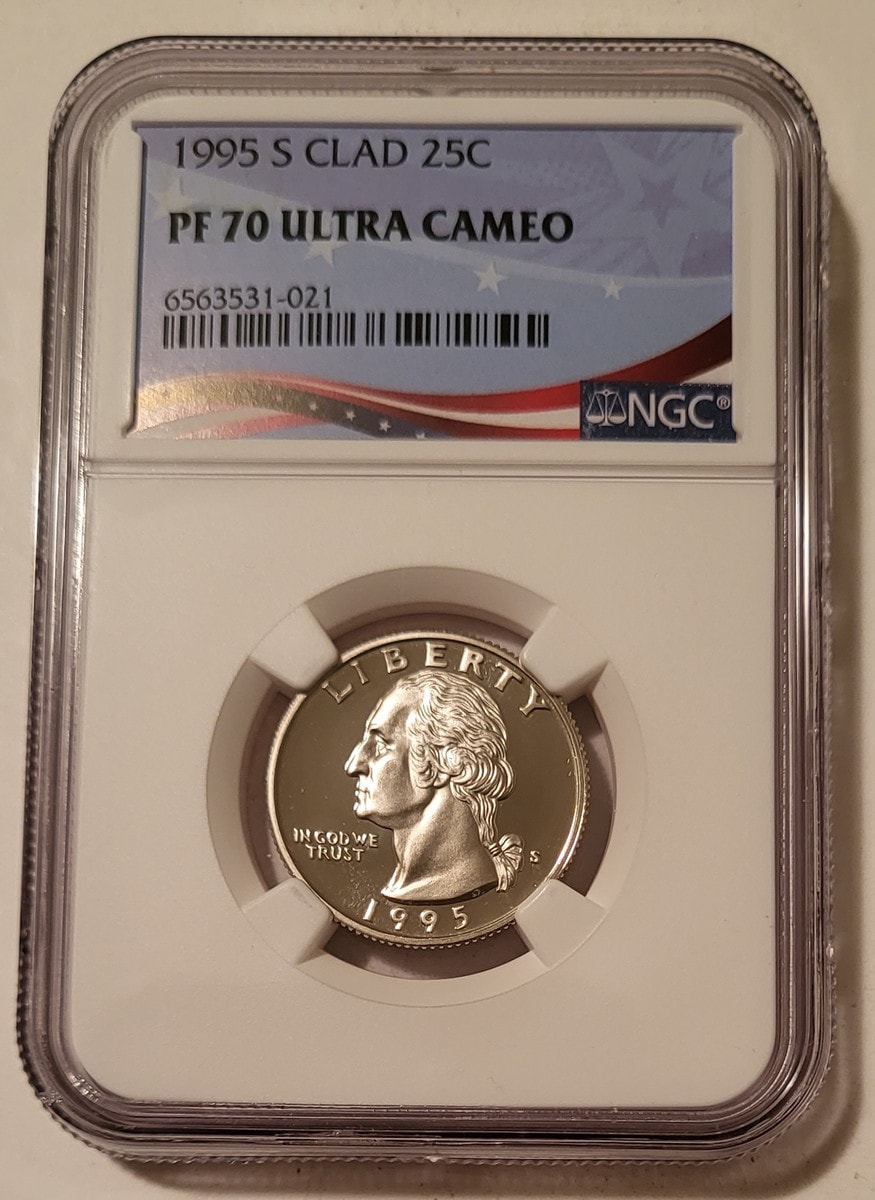
Just over 2 million clad proof quarters were produced at San Francisco in 1995. And as they were generally stored carefully as collectors’ items, it’s thought that about 1.8 million survive to this day.
Values are accordingly modest. A clad proof 1995 quarter at PR60 is worth around $5, and values stay flat all the way to a gem PR65. An example graded PR68 is worth around $10. And a flawless PR70 is valued at just $38.
That’s a small price to pay for a perfect coin.
Also read: Top 16 Most Valuable Modern Quarters Worth Money
Rare 1995 Quarter Errors List
1995 P Quarter, Partial Collar and Obverse Brockage
One very interesting error coin was a quarter struck in Philadelphia in 1995. It had two different types of error, known as a partial collar and a brockage.
Partial collars occur when the collar, which holds the planchet in place as the coin is struck, is out of position. That results in it leaving a line near the edge of the coin.
A brockage error occurs when a coin that’s already been struck sticks to the die. It’s then impressed into the next planchet, pressing its mirror image onto the blank face.
This particular coin had the brockage on the obverse side. And the partial collar had left a line near the top of the obverse, and at the bottom of the reverse, below the denomination.
The coin was graded MS64 by the coin grading agency the NGC. A standard 1995 P quarter at that level would have been worth single digits. But with the errors, this one sold at auction for $45.
1995 P Quarter, Obverse Brockage and Broadstruck
Another quarter struck in 1995 in Philadelphia combined two different error types.
This one also had a dramatic brockage on the obverse, obscuring three quarters of the design. And it was broadstruck – meaning it wasn’t held in place properly by the collar. As a result, the metal spread out further than it should have when the coin was struck.
This coin was graded MS64 by the PCGS, and sold at auction for $180.
You can take a look at both these error coins, and others, in detail in this YouTube video from Couch Collectibles.
Also read: 17 Most Valuable Quarter Errors Worth Money
Where to Sell Your 1995 Quarter ?
Now that you know the value of your coins, do you know where to sell those coins online easily? Don’t worry, I’ve compiled a list of these sites, including their introduction, pros, and cons.
Check out now: Best Places To Sell Coins Online (Pros & Cons)
FAQs
Is a 1995 quarter worth anything?
In the vast majority of cases, 1995 quarters are worth only their face value of 25 cents. Even in uncirculated condition, they’ll be worth between $1 and $10 at most grades.
The very finest coins, however, are worth much more. Find a 1995 D quarter graded MS67, and it will be worth around a thousand dollars. And a 1995 P quarter at the same level is worth twice that.
Coins with interesting errors can be more valuable too. The rarer and more dramatic the error, the more of a premium it will add to the value of the coin.
Is a 1995 S quarter silver?
Maybe! The San Francisco Mint facility struck both silver and clad quarters in 1995. So if your quarter has an S mint mark, look closely at the edge. If you can see any signs of brown or red metal, you have a clad quarter.
But even a solid silver color doesn’t necessarily mean your proof is silver. It could simply be in good condition with minimal wear.
To know for sure, you’ll need access to a very accurate weighing scale. A silver proof will weigh 6.3 grams (or slightly less, depending on how worn it is). A clad proof weighs 5.67 grams.

